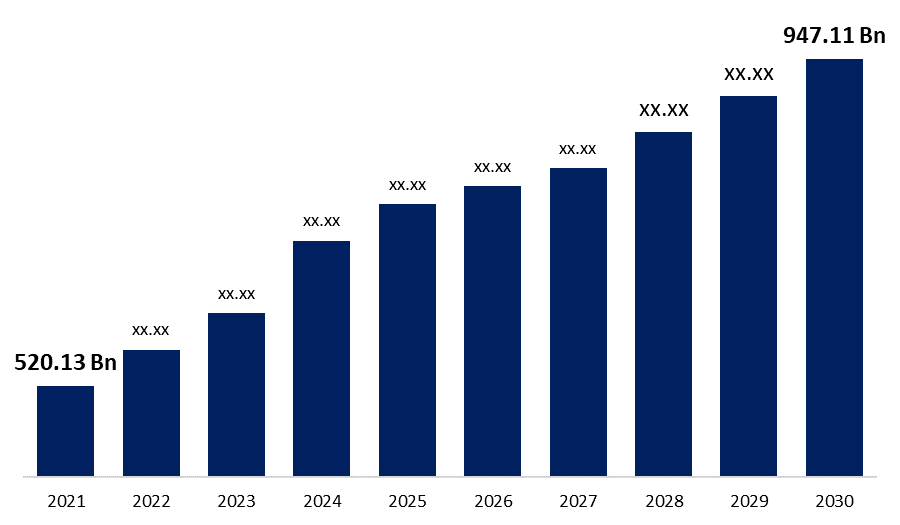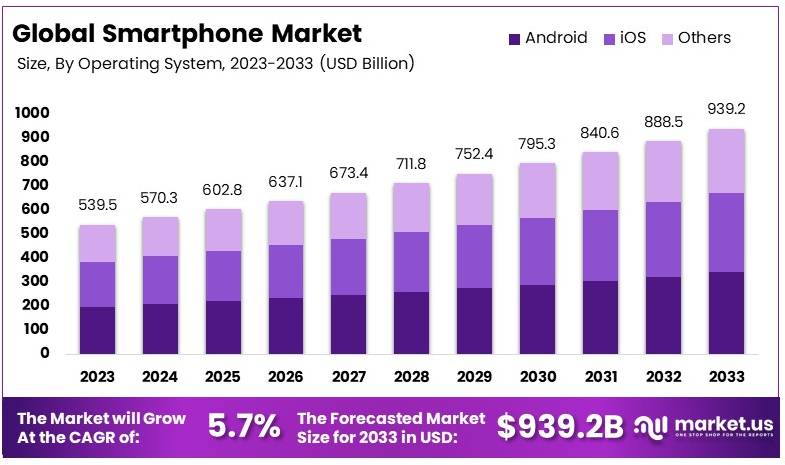Global Smartphone Market Trends: Insights into the Future of Mobile Technology
The smartphone market has undergone rapid transformation over the last few decades, evolving from a luxury item to an everyday necessity for billions of people across the globe. As of 2024, smartphones are no longer just communication tools; they are multi-functional devices central to work, entertainment, socializing, and even education. This ever-changing landscape is shaped by technological advancements, shifting consumer preferences, and economic trends, all of which are driving the growth and evolution of the smartphone market.
In this article, we will explore the latest trends within the global smartphone market, highlighting the forces shaping this dynamic industry. Whether you’re an industry insider, a tech enthusiast, or a business leader looking to understand the current and future direction of the smartphone sector, this guide offers essential insights into the market’s future.

Smartphone Market Growth and Forecast
The Evolution of the Smartphone Market
The global smartphone market has been experiencing significant growth over the past few years. This surge can be attributed to several factors, including:
- Increased Smartphone Penetration: With over 6.8 billion smartphone users worldwide as of 2024, smartphone penetration is higher than ever before. Statista reports that smartphones are becoming the primary devices for internet browsing, overtaking desktop computers.
- Rising Disposable Income: The increasing disposable income in emerging economies, such as India and China, has allowed more people to afford smartphones. This trend is expected to continue, with Asia-Pacific emerging as the largest smartphone market in the coming years.
- Technological Advancements: Continuous innovations in 5G technology, AI integration, and foldable smartphones have driven the demand for more advanced devices. Consumers are now looking for smartphones that offer more than just basic functionality.

Smartphone Market Size and Forecast
According to recent reports, the global smartphone market is expected to reach an estimated value of $800 billion by 2025, growing at a compound annual growth rate (CAGR) of 5-6%. This growth is fueled by rising smartphone adoption in developing countries, the launch of new technologies, and the continued demand for smartphone-based services such as e-commerce and mobile payments.
Despite a slight slowdown in growth during the pandemic, the smartphone market has shown resilience, with a strong recovery projected for the next decade. The middle class is expected to drive the market, with smartphone prices becoming more affordable while features continue to improve.
Key Trends Shaping the Global Smartphone Market
The smartphone industry is evolving rapidly, with several major trends shaping its future. Let’s dive into the most significant trends that are currently influencing the global market:
1. The Rise of 5G Smartphones
One of the most important advancements in the smartphone market is the rollout of 5G technology. The shift from 4G to 5G offers significantly faster internet speeds, lower latency, and more reliable connections, which will enhance the user experience for a range of applications, including gaming, video streaming, and IoT (Internet of Things) devices.
- 5G-enabled smartphones are already becoming mainstream, and as infrastructure continues to expand globally, the demand for 5G smartphones is expected to rise dramatically.
- Major players like Apple, Samsung, and Huawei are at the forefront of this shift, offering a range of 5G-capable devices to meet growing consumer demand.
Impact on the Market: As the 5G rollout continues, smartphones with 5G capabilities will dominate the market, driving up sales and encouraging the adoption of more advanced technologies.

2. The Emergence of Foldable Smartphones
Foldable smartphones have been gaining attention due to their innovative design and advanced features. These devices combine the portability of a smartphone with the functionality of a tablet. Companies like Samsung, Huawei, and Motorola have already released foldable models, and more are expected to follow suit.
- Flexible displays and hinge technologies are at the core of foldable devices, allowing for a new form factor that enhances productivity and multitasking.
- The high price point has been a barrier for widespread adoption, but as technology matures and production costs decrease, foldable smartphones will likely become more accessible to a broader consumer base.
Impact on the Market: Foldable smartphones are expected to reshape the market by offering unique user experiences, encouraging both early adopters and tech enthusiasts to invest in the latest innovations.
3. AI and Machine Learning Integration
Artificial intelligence (AI) is playing a significant role in the development of new smartphone features. Today’s smartphones are not just communication tools; they are smart devices powered by machine learning algorithms that improve user experiences.
- Camera improvements: AI helps enhance photo quality by adjusting settings in real-time and optimizing image processing. For instance, AI is used in portrait mode, low-light photography, and even video stabilization.
- Voice assistants: AI-powered voice assistants, such as Google Assistant and Siri, allow users to perform tasks hands-free, from sending messages to controlling home devices.
Impact on the Market: The growing use of AI and machine learning in smartphones will continue to enhance functionality, particularly in areas like camera quality, performance optimization, and user experience personalization.
4. Sustainable and Eco-Friendly Smartphones
Sustainability is becoming an increasingly important issue for consumers, and smartphone manufacturers are responding to this demand by developing eco-friendly devices. These devices are designed with recycled materials, energy-efficient components, and longer-lasting batteries to reduce environmental impact.
- Companies like Fairphone are leading the way by creating smartphones with modular designs, making it easier to repair and upgrade parts instead of replacing the entire device.
- Apple and Samsung are also taking steps to reduce their carbon footprint by using recycled materials in their products and adopting more sustainable manufacturing practices.
Impact on the Market: As consumers become more environmentally conscious, the demand for sustainable smartphones will rise, prompting manufacturers to focus on creating more eco-friendly options.
5. The Growing Popularity of Budget Smartphones
While flagship models from brands like Apple and Samsung remain popular, budget smartphones are seeing an increase in demand, especially in developing regions. These affordable smartphones offer essential features at lower price points, making them more accessible to a wider audience.
- In countries like India, Brazil, and Africa, budget smartphones are crucial for increasing smartphone penetration in emerging markets.
- Brands like Xiaomi, Realme, and Oppo are leading the way in providing affordable, feature-rich devices.
Impact on the Market: Budget smartphones are expected to remain a dominant force in the global market, contributing to the overall growth and increasing accessibility to mobile technology.
The Future of the Smartphone Market
Looking ahead, the smartphone market is poised for even more dramatic shifts, driven by innovation, evolving consumer preferences, and technological advancements.
- AI-driven experiences will continue to improve, with smartphones becoming even more integrated with our daily lives, anticipating our needs and providing seamless experiences.
- Augmented reality (AR) and virtual reality (VR) are set to become more mainstream, especially as new use cases are discovered in gaming, education, and e-commerce.
- Subscription-based services related to smartphones, such as software updates, cloud storage, and premium apps, will become more prevalent.
FAQs
1. What is driving the growth of the smartphone market?
The growth of the smartphone market is driven by increased smartphone penetration in emerging markets, the rollout of 5G technology, and innovations like AI, foldable smartphones, and budget-friendly options.
2. How is 5G affecting the smartphone market?
5G technology is revolutionizing the smartphone market by offering faster speeds, lower latency, and improved connectivity, which drives the demand for 5G-enabled smartphones.
3. What are the challenges facing the global smartphone market?
Challenges include market saturation in developed regions, supply chain disruptions, and environmental concerns related to the production and disposal of smartphones.
4. Which companies dominate the global smartphone market?
Companies like Apple, Samsung, Xiaomi, and Huawei are among the leading players in the global smartphone market.
Conclusion
The global smartphone market is evolving at an unprecedented pace, with cutting-edge technologies driving the demand for more sophisticated, efficient, and versatile devices. As the 5G rollout continues, foldable smartphones gain popularity, and AI-powered features enhance user experiences, the smartphone market is set to continue its growth trajectory. Whether you’re a consumer, investor, or industry professional, staying updated on these market trends will be essential to understanding the future of mobile technology.
For further insights on global smartphone trends, visit Market.us and stay ahead of the curve in this rapidly evolving industry.

